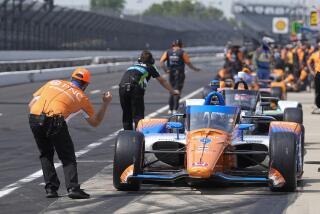Handford Device a Big Winner
- Share via
Those who were there for the CART FedEx championship race at Michigan Speedway in July are almost unanimous in declaring it the most exciting and competitive race in the history of Indy cars--or champ cars as CART cars are now labeled.
There were 62 lead changes, more than twice as many as at any previous race. And that only counted changes at the start-finish line. On many laps, three or four drivers took turns in front as the cars shuffled back and forth.
The reason for the close racing was the Handford device, a wing-like aerodynamic piece designed by Mark Handford of Swift Engineering in San Clemente. It was designed to slow cars from the frightening 240.942-mph qualifying lap at California Speedway for last year’s Marlboro 500. It accomplished that, but a side effect was a 500-mile trophy dash.
Only two sites need the Handford device, Michigan and California Speedways, two nearly identical two-mile banked ovals.
It doesn’t sound plausible, but the device reduces downforce in the corners, while increasing drag in the straightaways. The reduced downforce requires more driver skill to maneuver the car through the corners, at the same time trimming top-end speeds.
Because the downforce is lessened, drivers can try to pass without loss of tire grip. Thus, there are more passing opportunities.
It worked like magic at Michigan. It will be interesting to see if it works the same Sunday at California Speedway.
“The new Handford device has made racing on a superspeedway a lot of fun, with wheel-to-wheel racing and all that passing,” said Greg Moore, who passed Jimmy Vasser on the first turn of the final lap to win at Michigan.
Chip Ganassi, owner of the last three championship cars driven by Vasser in 1996 and Alex Zanardi in 1997 and this year, called it “the greatest CART race ever.”
The Michigan track record is 234.665 mph by Vasser in 1996. With the device, Adrian Fernandez was fastest at 229.519. The fastest lap during the race was 228.513 by Patrick Carpentier.
In Friday’s qualifying for the Marlboro 500, drivers don’t expect to come within two or three mph of the world closed-circuit record set last year by Mauricio Gugelmin in one of the PacWest Reynard-Mercedeses. During open practice recently in Fontana, Michael Andretti was fastest at 232.4 mph.
“We were running 232 and the car felt very comfortable,” he said. “The Handford device slows the cars here just like at Michigan.”
“It’s no easy job to slow cars down equitably. It sounds easy, but it’s not. Right now, I think Handford is the best solution. I have worked with Mark Handford for years at Newman-Haas and he is one of the--if not the--best aerodynamicists around.”
The device itself is a metal piece that fits on the rear panel of the car to create drag, the way a parachute operates, on the straightaway. It causes turbulence behind the car and allows a following car to draft and get in position to pass.
An adjustable flag, called a Gurney, allows the team to adjust the aerodynamic effect of the device. All other parts are controlled by strict rules.
Gil de Ferran, who drives for Derrick Walker, a member of the CART rules committee, says the device was necessary to reduce speeds.
“It’s not that the drivers can’t handle the speed,” said de Ferran. “That’s not the issue at all. It’s not that we can’t drive at 240 or even at 250. The driving is the same. It doesn’t require any special skill to go beyond 220.
“But if something unexpected goes wrong, a mechanical failure or an accident in front of you, an extra 30 mph will make the consequences that much bigger. After what we saw happening last year at Fontana [Gugelmin’s record speed], it is good common sense to see what can be achieved, both for safety and still make the racing better for the fans.”
More to Read
Go beyond the scoreboard
Get the latest on L.A.'s teams in the daily Sports Report newsletter.
You may occasionally receive promotional content from the Los Angeles Times.










